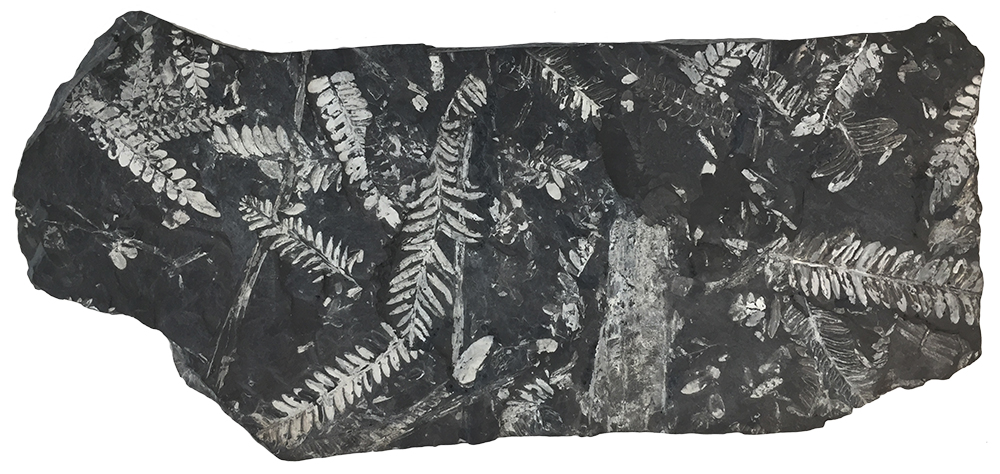
Llewellyn Formation, Pennsylvania (308 – 300 MYA)
From their black color and exquisite preservation of detail, you might initially think these fern fossils were simple examples of carbonization - a process in which an organism’s organic material is preserved as a carbon film in oxygen-lean environments. However, their fossilization process was more complex. These are instead fossil fern impressions covered by a white coating of pyrophyllite (a metamorphic alteration of the pyrite that originally replaced the plant tissues). Hence the original plant material was first pyritized and then that pyrite altered to pyrophyllite. Despite the multi-step alteration, even the smallest details of the ferns’ surfaces remain beautifully preserved.
Yet how did ferns last long enough to be altered and preserved? Ferns tend to be delicate; they decay easily and are quickly scavenged in most settings. However, these ferns were deposited in tropical coastal wetland swamps where the decay of tremendous volumes of plant debris quickly depleted the water’s oxygen to result in anoxic conditions that allowed plant material to accumulate. The buildup of organic material in these swamps led to immense coal deposits, so it is not surprising that these fossils were found in abandoned coal strip mines near St. Clair, Pennsylvania.
The ferns occur in cyclic deposits of the Upper Carboniferous Llewellyn Formation, a repetitive sequence of sandstones, siltstones, shale, conglomerate, and anthracite coal often referred to locally as ‘coal measures’. These sediments were originally deposited on a broad low relief plain, where sediment-filled streams delivered tremendous amounts of detritus from eroding upland areas. As sea level fluctuated, dense forests repeatedly gave way to swamplands and huge amounts of organic matter were buried and converted to coal. That coal has now been largely stripped away and consumed, with peak coal exploitation occurring in 1917 as the United Stated entered World War I.
Because of their repetitive cyclic nature, the sedimentary sequences in this region are known as cyclothems and they reflect relatively rapid sea level rise and fall as immense icesheets formed and melted across the southern continents as the supercontinent Pangea formed. This was the last time the Earth experienced glacial ice ages until roughly 2.5 million years ago when the Isthmus of Panama closed and altered ocean circulation patterns to start our present ice ages. However, the Upper Carboniferous ice sheets were also the first ice ages since life evolved on land. The combination of glacial cycles, fluctuating sea level, and abundant plant life led to the world’s first widespread coal measures, the same coal measures that elsewhere started Great Britain on its path to industrialization.
Hence, these fern fossils not only capture a moment in time, but indirectly reflect Pangea’s formation, ancient ice ages, and the cyclic deposition of resources that transformed our society and our history.